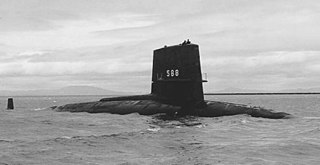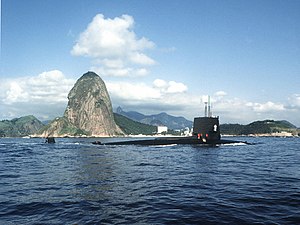
The fifth USS Truxtun (DLGN-35/CGN-35) was a nuclear powered cruiser in the U.S. Navy. She was launched as a destroyer leader and later reclassified as a cruiser. She was named after Commodore Thomas Truxtun (1755–1822). She was in service from May 1967 to September 1995.

USS Arnold J. Isbell (DD-869), a Gearing-class destroyer, was the only ship of the United States Navy to be named for Arnold J. Isbell, an aircraft carrier captain during World War II. The ship was laid down on 14 March 1945 at Staten Island, New York, by Bethlehem Mariners Harbor, launched on 6 August 1945 and commissioned on 5 January 1946. Constructed too late to see action in World War II, the vessel initially served as a training ship with the United States Atlantic Fleet, before transferring to the Pacific and deploying to Korea during the Korean War and off the Vietnam coast during the Vietnam War. In 1972 Arnold J. Isbell was made part of the reserve training fleet and in 1974, sold to Greece where the ship was renamed Satchouris and served with the Hellenic Navy until being sold for scrap in 2002.

USS Blueback (SS-581) is a Barbel-class submarine that served in the United States Navy from 1959 to 1990, and subsequently was made into an exhibit at the Oregon Museum of Science and Industry. She was the second Navy submarine to bear the name.

USS Robert E. Lee (SSBN-601), a George Washington-class fleet ballistic missile submarine, was the only ship of the United States Navy to be named for Robert E. Lee (1807–1870), the commanding general of the Confederate forces during the American Civil War.

USS Salmon (SSR/SS/AGSS-573), a Sailfish-class submarine, was the third ship of the United States Navy to be named for the salmon.

USS Omaha (SSN-692), a Los Angeles-class submarine, was the third ship of the United States Navy to be named for Omaha, Nebraska. The contract to build her was awarded to the Electric Boat Division of General Dynamics Corporation in Groton, Connecticut on 31 January 1971 and her keel was laid down on 27 January 1973. She was launched on 21 February 1976 sponsored by Mrs. Victoria Kuncl Hruska, wife of Senator Roman L. Hruska, and commissioned on 11 March 1978.

USS Wahoo (SS-565), a Tang-class submarine, was the second ship of the United States Navy to be named for the wahoo, a dark blue food fish of Florida and the West Indies.

USS Scamp (SSN-588), a Skipjack-class nuclear-powered submarine, was the second ship of the United States Navy to be named for the scamp, a member of the fish family Serranidae.

USS Sculpin (SSN-590), a Skipjack-class nuclear-powered submarine, was the second ship of the United States Navy to be named for the sculpin.

USS Plunger (SSN-595), a Permit-class submarine, was the third ship of the United States Navy to be named "plunger", meaning a diver or a daring gambler.

USS Haddo (SSN-604), a Permit-class submarine, was the second ship of the United States Navy to be named for the haddo, a pink salmon fish prevalent on the Pacific coast of the United States and Canada.

USS William H. Bates (SSN-680), a Sturgeon-class attack submarine, was planned to be the second U.S. Navy ship to be named USS Redfish—for the redfish, a variety of salmon also called blueback, sawqui, red salmon, and nerka—when the contract to build her was awarded to Ingalls Shipbuilding in Pascagoula, Mississippi, on 25 June 1968. However, upon the 22 June 1969 death of William H. Bates (1917–1969), the U.S. representative from Massachusetts's 6th congressional district (1950–1969) known for his staunch support of nuclear propulsion in the U.S. Navy, she was renamed William H. Bates and was laid down on 4 August 1969 as the only ship of the U.S. Navy to have borne the name. The reason for her naming by then-Secretary of the Navy John Chafee, breaking with a long-standing Navy tradition of naming U.S. Navy attack submarines for sea creatures, was best summed up by Admiral Hyman Rickover, the then-director of the Navy's nuclear reactors program, with the pithy comment that, "Fish don't vote!"

USS Pintado (SSN-672), a short hull Sturgeon-class attack submarine, was the second ship of the United States Navy to be named for the pintado, a large mackerel-like fish, whose elongated spots suggested the Spanish language word meaning "painted."

USS Tautog (SSN-639), a Sturgeon-class attack submarine, was the second ship of the United States Navy to be named for the Tautog, a wrasse commonly found along the Northern Atlantic coast. The submarine was in service from 17 August 1968 to 31 March 1997.

USS Aspro (SSN-648) was a Sturgeon-class submarine launched in 1969 and decommissioned in 1995. Scrapping was completed in 2000.

USS Drum (SSN-677), a Sturgeon-class attack submarine, was the second ship of the United States Navy to be named for the drum, also known as the croaker or hardhead, any of various fishes of the Sciaenidae family, capable of making a drumming noise and best known on the Atlantic coast of North America.

USS Bream (SS/SSK/AGSS-243), a Gato-class submarine, was the first ship of the United States Navy to be named for the bream. She served during World War II, and her war operations extended from 1 June 1944 to 15 June 1945. During this period she completed six war patrols operating in the Java Sea, Celebes Sea, Sulu Sea, South China Sea, and Gulf of Siam. She sank two Japanese merchant ships totaling 6,934 gross register tons. In addition, Bream shared with the submarines USS Ray (SS-271) and USS Guitarro (SS-363) the destruction of a 6,806-gross register ton passenger-cargo ship. On 23 October 1944, while patrolling off western Luzon, Bream made a daring surface attack on a Japanese naval force, damaging the heavy cruiser Aoba.

The fourth USS Vesuvius (AE-15) was laid down under a Maritime Commission contract by the North Carolina Shipbuilding Company, Wilmington, N.C.; launched on 26 May 1944; acquired by the United States Navy on 4 July 1944; and commissioned on 16 January 1945.

USS Brunswick (ATS-3) was an Edenton-class salvage and rescue ship in the service of the United States Navy from 1972 until her decommissioning in 1996.

USS Navasota (AO-106) was an Ashtabula-class replenishment oiler that served in the U.S. Navy from 1946 to 1973, then transferred to the Military Sealift Command to continue service as United States Naval Ship USNS Navasota (T-AO-106) until taken out of service in 1992. Navasota was sold for scrapping in 1995. She was the only U.S. Navy ship to bear the name Navasota.




















